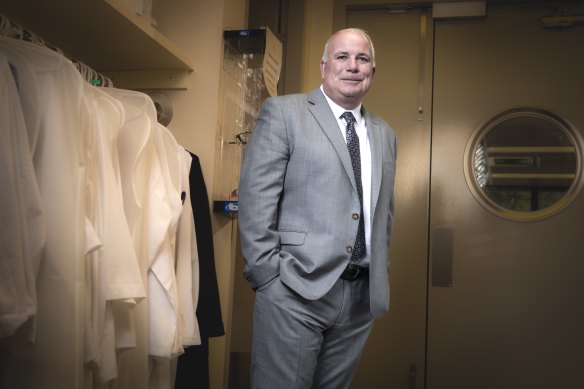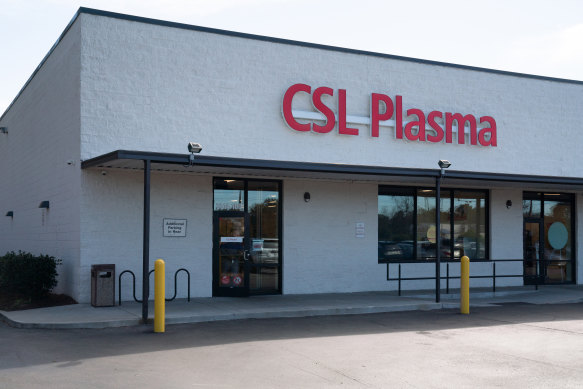By Emma Koehn
Biotech juggernaut CSL has big questions to answer when it reports 2023 earnings this week, including how it is managing costs in the post-pandemic era and the performance of the iron deficiency treatments business it bought in a huge $16 billion deal last year.
Shares in the $128 billion blood plasma giant have been under pressure since it revealed a profit downgrade in June, expecting foreign currency headwinds would hit its 2023 profits to the tune of $US250 million ($384 million). The company’s 2024 profit projections came in below market expectations at between $US2.9 billion and $US3 billion.

CSL boss Paul McKenzie took the top job in March. Credit: Eamon Gallagher
CSL shares have declined by 12.8 per cent over the past six months, closing at $266.08 on Friday, while the broader ASX 200 has dropped just 1 per cent over that period. But stock watchers are largely bullish about CSL’s long-term outlook. According to Bloomberg, the company has a consensus target price of $323.25 and 16 out of 20 analysts rate CSL as a buy.
Investors and analysts have never stopped believing in the long-term growth outlook of CSL, which is the third-largest listed business in the country and the largest business in the healthcare space.
“We do, however, think investors are becoming more demanding when it comes to the detail required to support growth forecasts,” UBS analyst Laura Sutcliffe said in a note to clients this week.
Investors will also want additional information on margins, particularly in CSL’s Behring business, which makes speciality medicines by refining human blood plasma.
The costs of collecting plasma surged during COVID, and the fees paid to bring donors into collection centres across the US have not settled back to what they were pre-pandemic.
“CSL have been quick to caution that the recovery will be gradual and seem slightly more conservative in their messaging than peers,” said senior investment analyst for WAM Leaders, Anna Milne.
CSL has been working to improve the efficiency of its plasma business, including introducing a new plasma collection technology called Rika, which cuts the time needed for each donation, but there have been delays in the system’s rollout.
“What will be interesting from the plasma collection side will be what progress has been made on the Rika device rollout,” Milne said.

A CSL plasma collection centre in Raleigh, North Carolina.Credit: Mehmet Demirci
Citi analysts said in a note to clients after the company’s update in June that they are expecting CSL Behring’s gross margins to recover to pre-COVID levels in 2027, later than previous forecasts of 2025. “The reasons for the delayed recovery are donor fees and labour cost inflation – both remain higher than what’s been previously anticipated,” Citi’s equities team said.
The company’s newest division, CSL Vifor, will also be under the microscope on Tuesday as the market hunts for more information about the competitive position of the portfolio of products CSL bought for $16.4 billion in 2022.
Vifor’s biggest product, an iron deficiency treatment called Ferinject, faces competition from generic competitors over the next year because of the expiration of the exclusivity of its patent this year.
“A known headwind when CSL purchased Vifor, we will be interested to hear of any developments in this space and CSL’s apparent comfort in retaining market share and price going forward,” Milne said.
The market was initially sceptical of CSL’s purchase of the Vifor business, given the big price tag and the fact the company’s portfolio of iron deficiency and kidney disease drugs was a departure from CSL’s long-term focus.
UBS notes that after weeks of discussions with investors in Australia and overseas, it is clear shareholders want clarity on how Vifor is expected to perform once generics hit the market.
“Vifor remains a black box for many we have spoken with,” the investment bank said in a note to clients.
The Business Briefing newsletter delivers major stories, exclusive coverage and expert opinion. Sign up to get it every weekday morning.